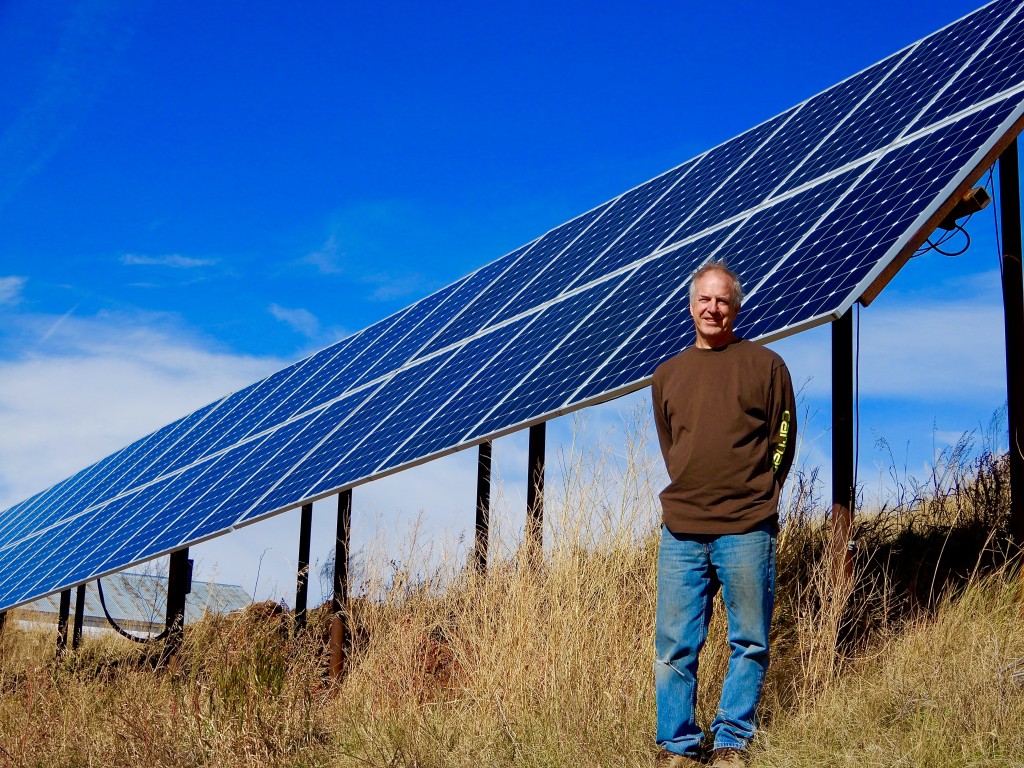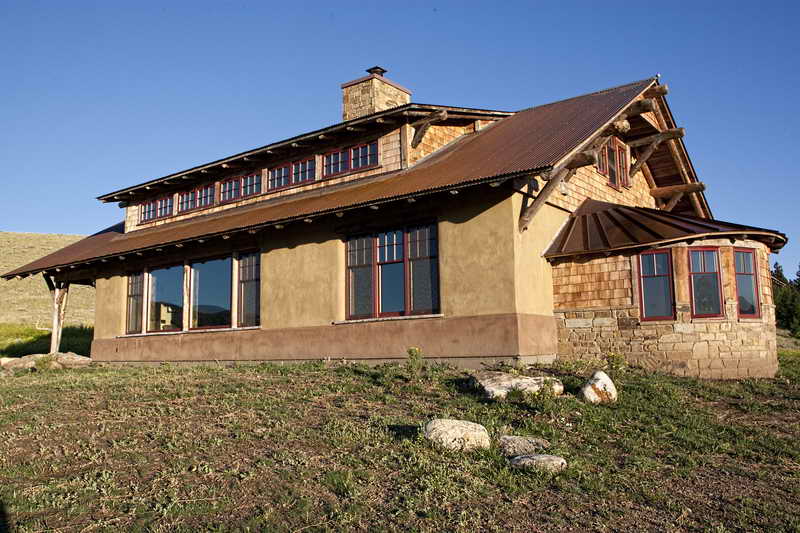Bud Barta was in the first wave of Americans who dedicated themselves to energy efficiency. Like so many others, Barta was awakened by the dual oil crises of the 1970s. America had become dangerously dependent on foreign sources of petroleum for heating and transportation. Electricity was generated mostly by high-sulfur coal, and nuclear power plants were sprouting up everywhere. The Lewistown, Montana home builder saw a better way to power our world.
Today, Barta operates multiple businesses in keeping with that better way. He lives and works on his central Montana farm where he raises grass-fed cattle and organic lentils. He and his two sons also build the most energy-efficient homes in the area. Barta, himself, lives in a positive energy home. Whether farming or building, Barta is guided by the practical philosophy of working with nature to glean what his customers need for health and comfort.
Like most custom builders, Barta has worked with a wide variety of clients. Many of them hire his company, Barta Built, because of the exceptional beauty and craftsmanship of his custom-built homes. But they also get something more: high energy performance that far surpasses current building codes. And still more clients seek him out specifically because of his reputation for high-efficiency home construction.
“Most of my clients aren’t necessarily interested in energy, but I give it to them anyway,” says Barta. Energy conscious details are part of the package, just like dead-level floors and tight joinery. Barta’s projects range from small and affordable homes to grand, Montana-style, timber and stone lodges. Several of the latter have been collaborations with Lewistown-based architect, Jeff Shelden of Prairie Wind Architecture. Together, they built their first strawbale project near Ennis, Montana that uses a fraction of the space heating energy of neighboring homes. This project benefited from southern orientation and a large site that allowed thoughtful house placement to capture great views as well as solar energy. Everyone has a budget, Barta points out. Keeping a high-efficiency project within budget takes thought, but is possible to accomplish.
Affordability
“My advice to anyone interested in building an energy efficient custom home is to study,” says Barta. “As you’re building, you may come up with great ideas. If you’re rigid, then you miss opportunities,” he says. “Take the time to learn about the details, so you can design it the way you want it. Then don’t be frozen to a plan.”
With a tight, well-insulated building envelope, an expensive heating system becomes unnecessary. Some clients want a ground-source heat pump or a hydronic radiant floor, but those systems can be overkill for an energy-efficient project. The key to comfort and efficiency is a solid building envelope. According to Barta, new construction doesn’t have to be expensive. “In 2005, I built a 1,380 square-foot energy-efficient house for $135,000,” he says. “Two of us finished it in 2-1/2 months.”
The Path to Efficiency
“The most important detail is air tightness,” says Barta. “You can put in lots of insulation, but it doesn’t matter if the home is leaky. I generally use casement windows, because they are tighter than other window styles.”
His earlier projects employed double-stud wall construction for thick insulation and airtight drywall (ADA) to reduce air leakage. More recent projects involve structural insulated panels (SIPs), which are made in nearby Belgrade, Montana. “With SIPs we get good insulation and air tightness. Once you train the crew, it’s simple,” says Barta. He generally specifies 8-inch wall panels. Because there are fewer thermal bridges in foam panels, this wall has about the same insulating value as a typical 2×6 stud wall with an inch of exterior rigid insulation sheathing.
He typically builds an R-50 roof with trusses, but Barta has a little trick to improve performance without adding cost. It’s well known among experienced builders that standard trusses don’t allow sufficient space for the full insulation thickness above the exterior walls. While special raised-heel trusses can be ordered, truss manufacturers often charge more for these. Instead, Barta orders a standard truss with a long overhang, as you would see in a Prairie-style design. The long overhang eliminates the pinch point and creates enough space for the full level of insulation to be installed across the entire ceiling.
Since most homes in Montana have basements, Barta generally uses insulating concrete forms for the basement walls. This gives a below grade insulating value of around R-25, and offers a good home for mechanical equipment.
Tight construction requires good indoor ventilation, which is supplied with a heat recovery ventilator (HRV). Winter temperatures in Montana can dip down to a very frigid -20°F. In such harsh conditions, HRVs shut down to prevent freezing up when they are needed the most. In earlier projects, Barta installed earth tubes to preheat the incoming fresh air. Although his projects never experienced a problem with condensation or ground moisture collecting in the tubes, he switched to an electric preheat coil to temper fresh air during the coldest times, eliminating any potential problems.

Bud Barta with the 13.5 KW solar array that powers his home, farm, and construction shop.
Walking the Talk
Barta lives on a third-generation farm spanning 1,200 acres. That’s considered small in Montana. He upgraded the original farm house with dense-pack, cellulose insulation, high-performance windows, and a ground-source heat pump for space heating. The latest addition is a heat pump water heater for household hot water.
The home, farm buildings, and construction shop are powered by a 13.5 kW solar electric system. The system is connected to the local electric cooperative’s grid. Barta’s system generates excess power during the summer months and builds a credit with the co-op that can be used the following winter. Each year in April, his bank of credits is reset to zero and the annual process starts over again. While he pays nothing for energy, his monthly bill does include a $40 per month administrative fee, which is higher than many other utilities. The solar electric system on his property also provides about 25% of the energy needed to operate his plug-in hybrid Chevy Volt. The car’s 50-mile battery range is enough to take him to town and back without the backup gasoline engine kicking in.
The Next Steps in Efficiency
Barta sees two steps necessary to push housing toward higher levels of efficiency and even on to zero energy: stronger building codes and recognition of the true value of efficient homes by real estate appraisers.
“I had a Realtor® tell me that my houses sell for 20% more because they are energy efficient,” he says. “Appraisers haven’t recognized that value. They have a standard form, and energy isn’t on it. They don’t look at lifetime cost. One of our homes with double-stud walls heats for $100 a year,” he says. There’s a simple solution to this common problem. Appraisers can use an Energy Addendum to document the additional value of energy-efficient property.
While farming is Barta’s first love, clients throughout Montana are happy that he has applied his passion and skills to construction as well. As a veteran of the first wave of energy conservation and a man nearing retirement, Bud wonders how society will be able to pass the energy-conscious torch to future generations. While millennials show considerable interest in climate change and environmental protection, they often lack the funds for homeownership. Cost-effective, energy-efficient new construction and remodeling, like Barta practices, could make homeownership more attainable for this next generation.


Don Jackson says:
Would love to tour Bud’s property